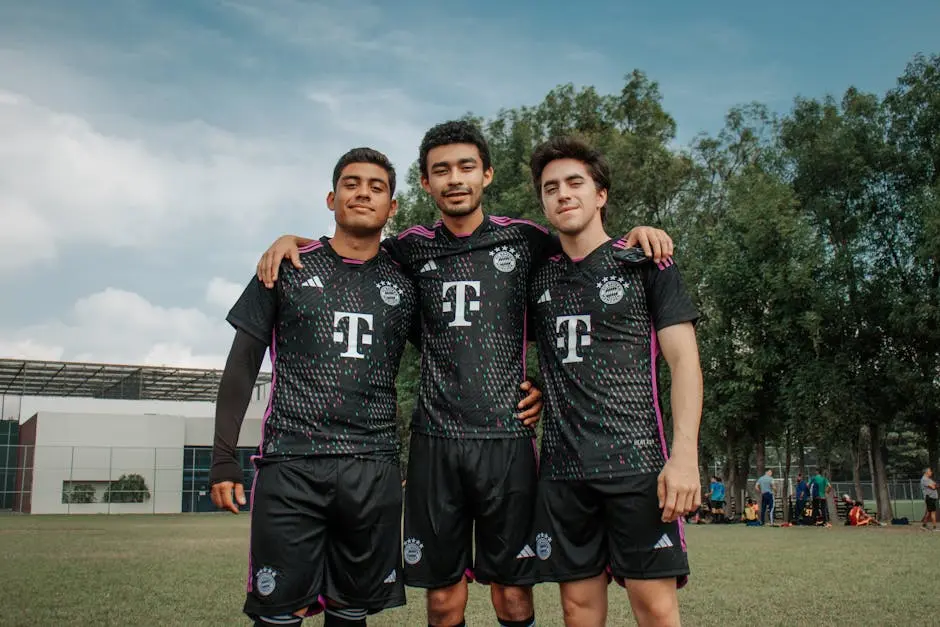Soccer jerseys have come a long way from their humble beginnings. What started as simple garments in plain colors have transformed into sophisticated pieces of sportswear, complete with cutting-edge fabrics and striking designs. In this blog, we’ll take a journey through the evolution of soccer jerseys, exploring how they have changed over the decades and the impact these changes have had on the sport.
The Early Days of Soccer Jerseys
In the early days of soccer, jerseys were simple and lacked the features we now take for granted. Players often wore button-up shirts of wool or cotton, in colors chosen to signify their team affiliation. There were no logos or team names, just solid colors or simple patterns. The weight and unwieldy nature of these early jerseys meant that performance on the field was often compromised, as players dealt with the discomfort of heavy, sweat-soaked shirts. Despite these limitations, these jerseys became powerful symbols of identity and pride, with fans and players alike feeling a deep connection to their team colors.
The distinct colors of these jerseys made it easier for players to identify teammates during a game. While this simplicity served a purpose, it left little room for individual expression or innovation. However, from these humble beginnings, soccer jerseys began their journey towards becoming the vibrant, technologically advanced pieces they are today. In the 1920s, the addition of numbers was an important step. Numbers on jerseys helped fans and referees differentiate between positions, marking another milestone in the advancement of the soccer jersey as a tool for the game.
The Introduction of Synthetic Fabrics
The 1970s was a transformative era for soccer jerseys, introducing synthetic fabrics like polyester. These new materials offered a level of comfort and flexibility that was previously unattainable, allowing players greater freedom of movement on the pitch. Synthetic fabrics opened up a world of possibilities in terms of vibrant colors and designs, thus beginning an era where aesthetics became almost as important as functionality. The likes of Adidas and Puma, major sports apparel brands, began crafting bespoke jersey designs that excited players and fans alike.
This shift was not only a matter of comfort or performance; it was cultural. Colors became symbols, helping teams define their identity. Iconic jerseys, like Brazil’s classic yellow and green kit, became inseparable from the victories achieved wearing them. The move away from wool to polyester didn’t just change how jerseys looked and felt; it reshaped the industry, paving the way for the dynamic fusion of fashion and function that modern jerseys epitomize.
Sponsorship and Branding Take Center Stage
Sponsorship deals began to make their mark in the 1980s, turning jerseys into prime advertising spaces. This period marked a significant shift. Club names were no longer the only notable features on jerseys—brands and corporate logos began to share this spotlight. The commercialization of jerseys meant the designs not only needed to cater to player comfort but also fit the branding and marketing needs of sponsors. Clubs saw the potential for significant revenue growth, and soon, sponsorship became an integral part of the jersey’s identity.
However, fans had mixed feelings about these changes. While some viewed brand logos as a necessary evolution to financially support teams, others saw them as a corruption of the purity of the game. Still, the era of sponsorships birthed a variety of designs that were both functional and artistically appealing. The introduction of names on the back of jerseys personalized them, allowing fans to express their admiration for players by wearing replicas. This phase solidified the jersey’s role beyond sportswear, transforming them into valuable collectables and crucial elements of club culture.
Modern Tech and Smart Fabrics
As we step into the present, soccer jerseys are more than just a kit; they are technological marvels. Current jerseys utilize smart fabrics designed to optimize performance by regulating body temperature, improving moisture management, and even reducing wind resistance. These developments help enhance the player’s comfort and performance by allowing them to focus solely on the game. Equally, innovations like 3D printing and thermoregulation have demonstrated that there is no limit to how technologically advanced jerseys might become.
Incorporating sustainable practices into production is now a trend that continues to emerge as clubs respond to the global call for environmentally friendly practices. Combining performance-enhancing features with eco-friendly materials is indeed a testament to how far the manufacturing of soccer jerseys can reach. These advancements ensure that today’s jerseys not only look great but also contribute positively to the planet. Such considerations are becoming as much a priority as the cutting-edge designs fans have come to expect.
The Future of Soccer Jerseys
As we anticipate the future of soccer jerseys, the potential for evolution seems boundless. There is significant interest in eco-friendly materials, as well as technological integration that might include sensors to monitor performance. The prospect of customizable jerseys where fans can incorporate their distinct preferences is another exciting development on the horizon. As we progress, jerseys will likely become even more personalized, forming a deeper bond between fans and their teams.
Moreover, with the global market’s growing influence in fashion, jerseys continue to evolve as cultural icons and fashion statements, appearing not only in stadiums but also in high-street fashion stores. The line between sportswear and casual wear is continually blurring, and the future is ripe with unlimited creative potential. This evolution highlights that soccer jerseys will remain vital tools in bridging sports culture and daily life beyond the pitch.
Soccer Jerseys: More than Just Apparel
The evolution of soccer jerseys reflects not just changes in fashion and technology but also the growing importance of branding and fan engagement in soccer. As we look to the future, it’s exciting to imagine the next strides in jersey design, both in terms of materials and aesthetics. One thing is certain—soccer jerseys will continue to be more than just gear; they will remain symbols of team spirit and fan loyalty.

